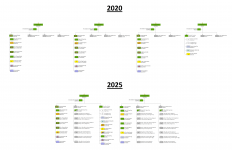I'll take a shot...
We consolidate.
1 x Heavy Brigade in the West. 1/2/3 PPCLI all LAV Battalions and LdSH a Cavalry Regiment along the lines being discussed in the Armoured Recce threads (Tanks & Recce elements). 1RCHA would get a 3rd Battery (from 5RALC) and be equipped with SP 155mm.
1 x Light Brigade in the East with 1RCR (Petawawa)/1R22eR (Valcartier)/2RCR (Gagetown) all Light Battalions. The infantry, RCD, 2RCHA, 2 CER and 2 Service all equipped to be air transportable as our Rapid Reaction Force. 2RCHA would get a 3rd Battery (from 5RALC) and be equipped with M777s.
The following units would move to the Canadian Combat Support Brigade and be re-roled and re-equipped as follows:
- 12RBC - Re-roles as a Sense/Strike Regiment with LAV LRSS and LAV-UAV/Loitering Munitions vehicles.
2R22eR - Re-roles as an AT Battalion with LAV-ATGMs [Edit: Dropped per informed comments. Integrate LAV-AT vehicles into existing CS elements]- 2R22eR - Re-roles as an AA Battalion with LAV-SHORAD
- 5RACL - HQ and STA Batteries remain. 2 x Reg Force Gun Batteries to 1RCHA and 2RCHA. Gains 3 x Reserve Gun Batteries equipped with SP 155mm. Regiment to act as General Support artillery for any deployed Brigade Group.
- 5CER - Becomes the Combat Engineer Regiment for the CCSB
- 5Svc - Becomes the Service Battalion for the CCSB
3RCR
and 3R22eR [added] would be disbanded and the troops distributed to the 6 x remaining Infantry Battalions
and the 3 x Reserve Brigade HQ's [added] (along with the surplus infantry troops from 2R22eR as the SHORAD battalion will not require as many personnel as an Infantry Battalion).
Consolidate the Reserves into 3 x Reserve Light Infantry Brigade Groups. The Infantry Regiments from each existing Reserve Brigade would be consolidated into a single Infantry Battalion. The Armoured, Artillery, Combat Engineer and Service Regiments/Battalions would be composite units from across all the existing Brigades.
- 3 (Res.) Brigade (from existing 31/32/33 Brigades)
- 4 (Res.) Brigade (from existing 38/39/41 Brigades)
- 5 (Res.) Brigade (from existing 34/35/36/37 Brigades)
All this can be done with minimal new equipment. SP 155's are already part of an indirect fire program. The LAV-AT, LAV-SHORAD and LAV-UAV's can all be obtained by using existing LAV hulls plus the same RiWP Remote Weapon Station with different weapon mounting options, but as a short-term expedient these specialty units could still be re-roled using MANPAD AT/SAM/UAV launchers until dedicated vehicle upgrades are possible.
Not a perfect solution, but a good short-term solution to reduce manning pressures, HQ overhead and key capability gaps.



